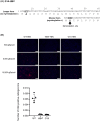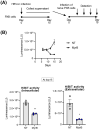A single hepatitis B virus genome with a reporter allows the entire viral life cycle to be monitored in primary human hepatocytes
- PMID: 35691027
- PMCID: PMC9426382
- DOI: 10.1002/hep4.2018
A single hepatitis B virus genome with a reporter allows the entire viral life cycle to be monitored in primary human hepatocytes
Abstract
For the development of antiviral agents to eliminate hepatitis B virus (HBV), it is essential to establish an HBV cell culture system that can easily monitor HBV infection. Here, we created a novel HBV infection monitoring system using a luminescent 11-amino acid reporter, the high-affinity subunit of nano-luciferase binary technology (HiBiT). The HiBiT-coding sequence was inserted at the N-terminus of preS1 in a 1.2-fold plasmid encoding a genotype C HBV genome. After transfection of HepG2 cells with this HiBiT-containing plasmid, the supernatant was used to prepare a recombinant cell culture-derived virus (HiBiT-HBVcc). Primary human hepatocytes (PXB) were inoculated with HiBiT-HBVcc. Following inoculation, intracellular and extracellular HiBiT activity and the levels of various HBV markers were determined. Reinfection of naive PXB cells with HiBiT-HBVcc prepared from HiBiT-HBVcc-infected PXB cells was analyzed. When PXB cells were infected with HiBiT-HBVcc at several titers, extracellular HiBiT activity was detected in a viral titer-dependent manner and was correlated with intracellular HiBiT activity. Inhibitors of HBV entry or replication suppressed extracellular HiBiT activity. Viral DNA, RNA, and proteins were detectable, including covalently closed circular DNA, by Southern blot analysis. The synthesis of relaxed-circular DNA from single-stranded DNA in HiBiT-HBV decreased to one third of that of wild-type HBV, and the infectivity of HiBiT-HBVcc decreased to one tenth of that of wild-type HBVcc. HiBiT-HBVcc prepared from PXB cells harboring HiBiT-HBV was able to infect naive PXB cells. Conclusions: Recombinant HiBiT-HBV can undergo the entire viral life cycle, thus facilitating high-throughput screening for HBV infection in vitro using supernatants. This system will be a powerful tool for developing antiviral agents.
© 2022 The Authors. Hepatology Communications published by Wiley Periodicals LLC on behalf of American Association for the Study of Liver Diseases.
Conflict of interest statement
Nothing to report.
Figures







Similar articles
-
Exploring the tolerable region for HiBiT tag insertion in the hepatitis B virus genome.mSphere. 2024 Oct 29;9(10):e0051824. doi: 10.1128/msphere.00518-24. Epub 2024 Sep 30. mSphere. 2024. PMID: 39345122 Free PMC article.
-
High-Throughput Screening of Antiviral Compounds Using a Recombinant Hepatitis B Virus and Identification of a Possible Infection Inhibitor, Skimmianine.Viruses. 2024 Aug 22;16(8):1346. doi: 10.3390/v16081346. Viruses. 2024. PMID: 39205320 Free PMC article.
-
Infection courses, virological features and IFN-α responses of HBV genotypes in cell culture and animal models.J Hepatol. 2021 Dec;75(6):1335-1345. doi: 10.1016/j.jhep.2021.07.030. Epub 2021 Aug 4. J Hepatol. 2021. PMID: 34363922 Free PMC article.
-
Virological Basis for the Cure of Chronic Hepatitis B.ACS Infect Dis. 2019 May 10;5(5):659-674. doi: 10.1021/acsinfecdis.8b00081. Epub 2018 Jun 25. ACS Infect Dis. 2019. PMID: 29893548 Free PMC article. Review.
-
Hepatitis B virus biology and life cycle.Antiviral Res. 2020 Oct;182:104925. doi: 10.1016/j.antiviral.2020.104925. Epub 2020 Aug 28. Antiviral Res. 2020. PMID: 32866519 Review.
Cited by
-
Monitoring of hepatitis E virus infection and replication by functional tagging of the ORF2 protein.JHEP Rep. 2024 Dec 5;7(3):101293. doi: 10.1016/j.jhepr.2024.101293. eCollection 2025 Mar. JHEP Rep. 2024. PMID: 39991067 Free PMC article.
-
Exploring the tolerable region for HiBiT tag insertion in the hepatitis B virus genome.mSphere. 2024 Oct 29;9(10):e0051824. doi: 10.1128/msphere.00518-24. Epub 2024 Sep 30. mSphere. 2024. PMID: 39345122 Free PMC article.
-
Development of a reporter HBoV1 strain for antiviral drug screening and life cycle studies.Virol Sin. 2025 Apr;40(2):275-283. doi: 10.1016/j.virs.2025.03.009. Epub 2025 Mar 25. Virol Sin. 2025. PMID: 40147635 Free PMC article.
-
High-Throughput Screening of Antiviral Compounds Using a Recombinant Hepatitis B Virus and Identification of a Possible Infection Inhibitor, Skimmianine.Viruses. 2024 Aug 22;16(8):1346. doi: 10.3390/v16081346. Viruses. 2024. PMID: 39205320 Free PMC article.
-
Integration of HiBiT into enteroviruses: A universal tool for advancing enterovirus virology research.Virol Sin. 2024 Jun;39(3):422-433. doi: 10.1016/j.virs.2024.03.004. Epub 2024 Mar 16. Virol Sin. 2024. PMID: 38499155 Free PMC article.
References
-
- Polaris Observatory Collaborators . Global prevalence, treatment, and prevention of hepatitis B virus infection in 2016: a modelling study. Lancet Gastroenterol Hepatol. 2018;3:383–403. - PubMed
Publication types
MeSH terms
Substances
LinkOut - more resources
Full Text Sources
Medical

